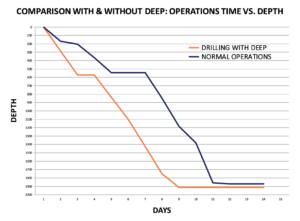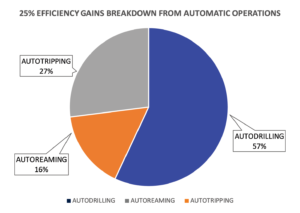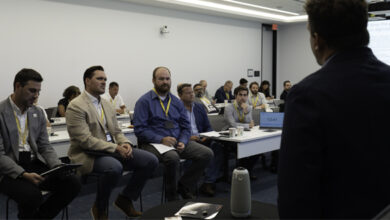Process automation drives rig to new levels of efficiency, safety focus
HH-Series rig combines cost-effective technology with existing machinery to enable automated tripping and drilling, turn driller’s attention back to drill floor
By Gilberto Gallo, Drillmec
In a continuously evolving competitive environment where drilling rig innovations often don’t get a long enough time cycle to earn a competitive ROI, rig design is caught in between necessity and economic feasibility. Further, the focus of drilling rig advances has shifted from structural and mechanical improvements to software and process-based ones, generating a multitude of data-driven progress and innovations.

It can be said that new requirements for system integration of the whole drilling package, data touch points and processes are being prioritized over other areas of development. This trend has resulted in the incorporation of machine learning and artificial intelligence, leading to advanced data analyses that facilitate improvements in drilling performance, equipment reliability and maintenance, and safety.
These same advances have also allowed for conventional, operations-based progress, especially by using data benchmarking to explore patterns and trends.
Combining these advances together has led to dramatic reductions in the drilling time for vertical wells. In fact, 1,000 of today’s modern rigs are capable of covering more ground than 4,000 rigs could during the 1980s. This achievement has come about after multiple cycles of incremental technology evolutions, and it underscores the importance of innovation, particularly during a down cycle.
Historically, Drillmec’s approach to drilling rig innovation has been to simultaneously pursue safety and performance through the development and utilization of automation technologies. This article discusses the latest achievement in the HH-Series hydraulic hoist rigs, illustrating how this 25-year evolution culminated in fully automatic rig operations.
The technological advances discussed here represent different incremental innovations, both in equipment and automation.
Evolution in the HH-Series
The origin of the HH-Series started in 1993, as a simple G-75 hydraulic rig for water wells in Italy; these rigs are still active in Ukraine today. The mobility and efficiency of this 165,000-lb (75 metric ton) hookload rig laid the groundwork for the development of larger models for oil and gas drilling and workover operations. The focus was to achieve a compact layout with optimized rig-up and rig-down operations. In particular, the semi-automatic functions in the pipe handler would be the basis for the next big step toward complete automation.
The HH-Series design differed from conventional land drilling rigs because it did not present a conventional mast structure, or drawworks, drill lines or traveling equipment. These were replaced by a hydraulic cylinder, which served as the main hoisting element of the rig, situated on a self-standing telescopic mast with reduced height. It is permanently mounted on a trailer for fast mobilization. This hoisting system is very similar to what’s used today, as it is based on a telescopic mast and operates as a hydraulic hoist. It was designed to allow handling of API range 3 (45-ft) drill pipes, 30-ft drill collars and API range 3 (45-ft) casings.
This patented design presented a tilting top drive installed on said telescopic mast, in combination with drill pipes stacked in vertical pipe bins.
The pipe handler would rotate inside a unique vertical pipe rack surrounding the rig floor. The pipe handler’s arms, installed on a vertical rotating tower, had two clamps grabbing the drill pipes from the pipe bins and moving them to the mouse hole or vice versa, depending on an electronic pre-set order. Then, the top drive would pick up the pipe from the mouse hole, lift it and tilt it to the nearby pipe string in the center hole.
This change further reduced the rig’s footprint, allowing for the vertical stacking of drill pipes, instead of the conventional horizontal stacking on the ground; this also improved the feeding of the pipes.
In 2002, thanks to this design, the automatic pipe-handling system created a natural yet disruptive evolution that combined safety with efficiency.
The system was capable of autonomously moving drill pipes from the vertical pipe racks to the mouse hole, and of making up and breaking the pipe connections in combination with a hydraulic iron roughneck. This effectively removed the drill crew from the drill floor, resulting in additional efficiencies and fewer liabilities.
While several other advances were achieved with HH rigs in the decade that followed, including skidding systems, walking systems, offshore applications and adaptation, and deployment in harsh environments, the next major automation milestone occurred in 2015. In fact, automation of routine drilling operations has led to the latest version of the HH rigs, with fully automatic operations.
Case Study: Fully automatic operations through process automation data platform
Concept
The basic concept was to identify repetitive operations that could be automated in order to lower costs while maintaining consistency in performance and safety. Therefore, the objective of achieving fully automatic operations was to generate affordable innovation based on existing equipment, while also improving safety and efficiency.

A vertically integrated operator/drilling contractor was identified as the ideal partner. It was recognized that the feasibility of this development depended on the cooperation and availability of the client, primarily during the implementation and fine-tuning phases.
In this generation of HH rigs, a more advanced cyber cabin was introduced, with more data points and the application of machine learning and AI through Drillmec’s Embedded Efficiency Platform (DEEP). The platform was designed to automate repetitive operations and integrate a data system that gathers rig and drilling information to optimize performance, safety and maintenance through just-in-time analyses and action plan suggestions. Its AI data-driven approach utilizes pattern recognition and produces different operational efficiencies through Pro-Driller for drilling operations and Pro-Rig for rig durability and integrity. Pro-Driller optimizes and automates drilling operations, providing the driller with safe and simplified operations and improving performance and data management. It also reduces rig crew risk exposure on the rig floor.
Development & Implementation
Since the previous generation of HH rigs could already perform automatic pipe handling, the main target here was to develop automatic tripping and drilling in order to achieve:
- Consistent performance;
- Operational predictability;
- Continuous AI monitoring and re-processing of data; and
- Re-focus of driller’s attention on the drill crew’s safety.
Most sensors needed for these purposes were already in place to serve as data points, while proprietary data acquisition and processing software from DEEP’s Pro-Driller were implemented. Multiple parametric check points and coherence supervision functions were developed and deployed to optimize weight-to-weight connection times with AI monitoring.
Specifically for automatic tripping operations, a quadruple parametric check was performed.
DEEP generates efficiencies spanning drilling automation, safety and data management. Automatic tripping, drilling and reaming were the most notable, accounting for most of the efficiency gains analyzed.
The development of the new system occurred in two steps. The first phase involved an endurance test at the factory, once the system was calibrated and fine-tuned, in a predictable and controlled environment.
The second phase was field deployment, where software adjustments were made to address client feedback.
Among others, the most significant hurdles encountered were:
- Sensor calibration and suitability for expected operations;
- Software stability and false alarms;
- Software accessibility and ease of adoption;
- Operational consistency;
- Crew acceptance of the system and training; and
- System troubleshooting by rig crews.
Emphasis was given to training the drill crew on the system and the new rig floor operational procedures. After monitoring a few wells, the system was deemed safe, efficient and satisfactory both by the customer and manufacturer.
Results & Conclusions

After four years of continuous progress, an overall 25% efficiency gain was recorded. Figure 1 showcases a comparison of similar wells drilled with an HH-300 in Europe with and without DEEP. The graph compares normal drilling performance in 2016 before the application of the system and the overall speed achieved through automatic operations in the same area.
Figure 2 illustrates the time gains by overall contribution, while Figure 3 represents the well activity breakdown. The graphs show that, while the tripping operations RIH and POOH accounted for just under 10% of the time spent on the well, they generated 27% of the performance improvement.
The 25% efficiency gain indicates consistent and steady performance compared with a human driller’s average performance. The system recorded 98% reliability on automatic drilling operations over the past year.
Additionally, no lost time related to system inefficiencies was recorded, as was an excellent HSE track record and better equipment durability.
The Next Step
The evolution of the HH-Series rigs has come full circle, with cost-effective technology applied to existing machinery resulting in efficiency improvements through process automation. The next step is to apply the same concepts and lessons learned to conventional land drilling rigs that present different challenges from the super single rigs.
In 2018, this led Drillmec to design a robotic, electric pipe-handling system that allows offline stand-building of drill pipes and casing while drilling operations are ongoing.
The application of automatic operations to conventional land rigs will become reality in 2021, as the first units will be deployed to their assigned field in Asia for a major operator.
It replicates the concept of the HH rigs, both with moving the drill crew away from the drill floor and with automating repetitive tasks, letting the driller focus on safety instead.
This pipe-handling system, in combination with special catwalks that can provide DEEP with specific tubular information, is the next step of using technology to safely speed up drilling operations. DC
This article is based on a presentation at the 2020 IADC Advanced Rig Technology Conference, 1-2 September.




